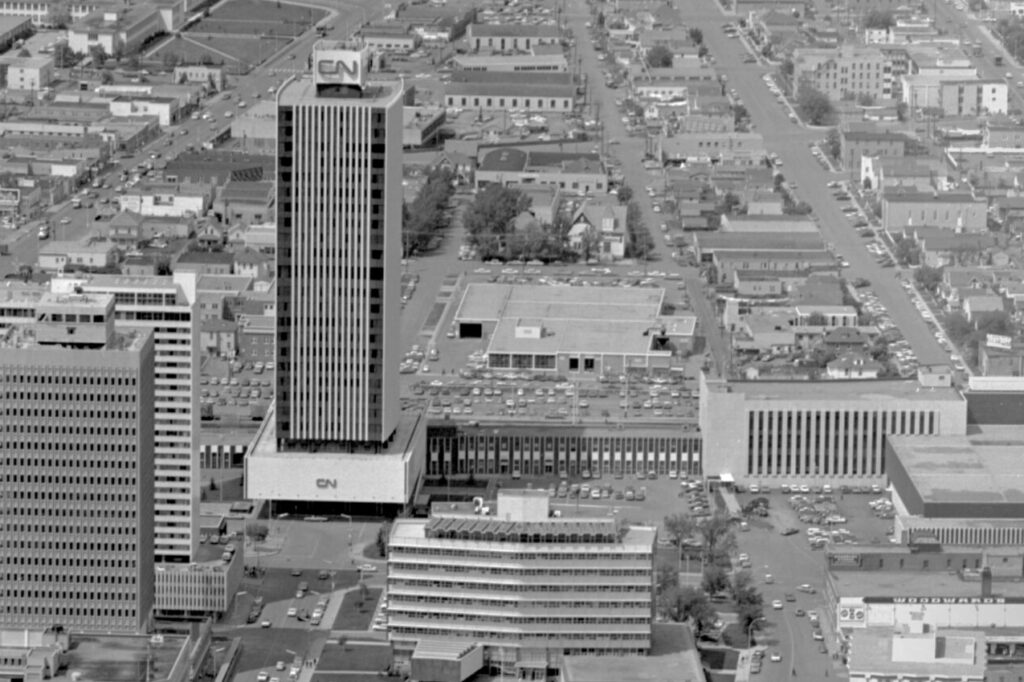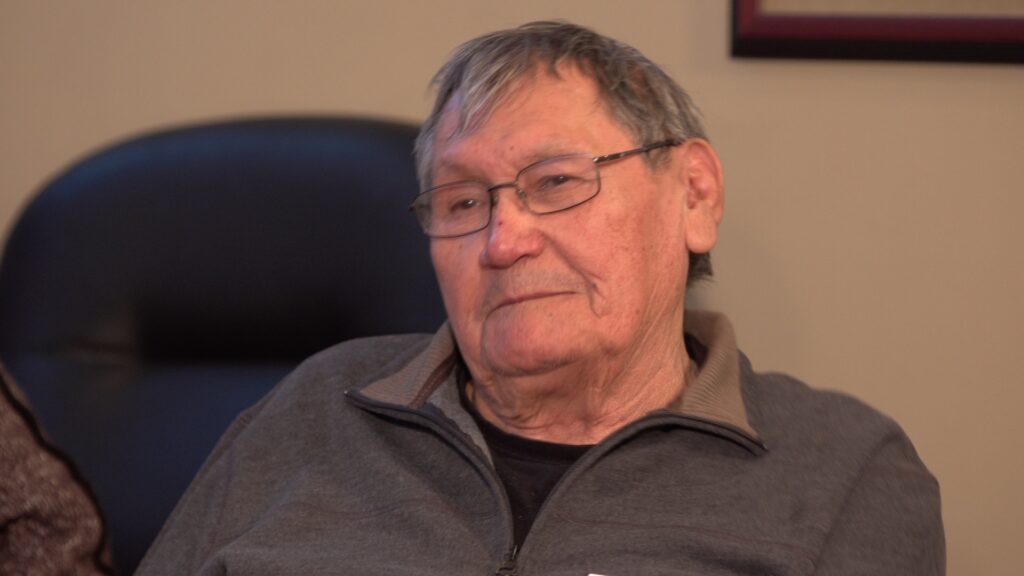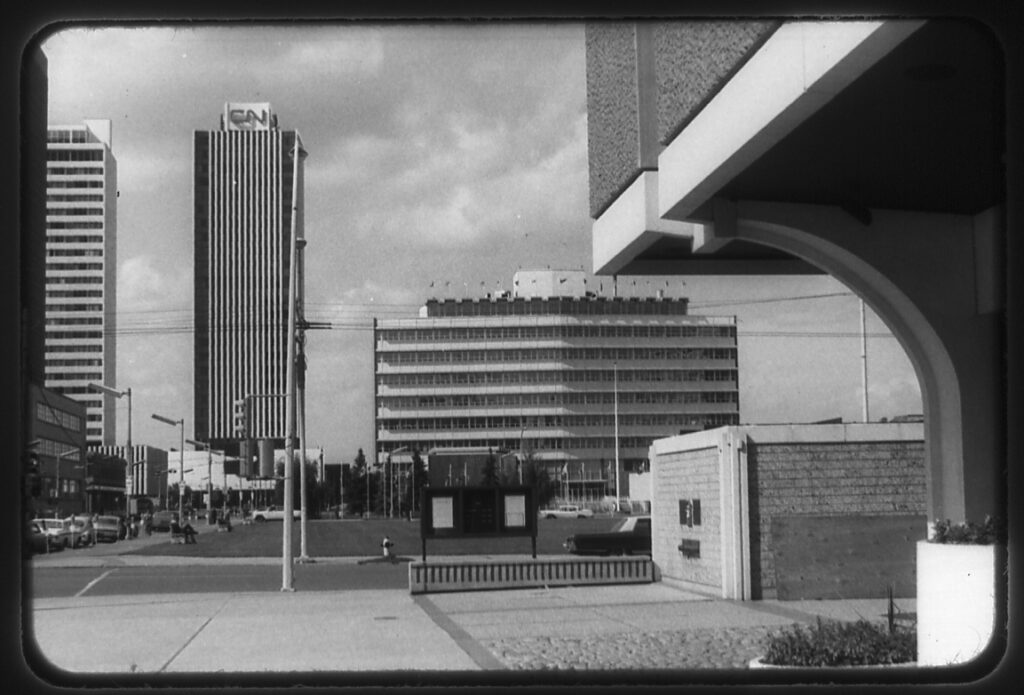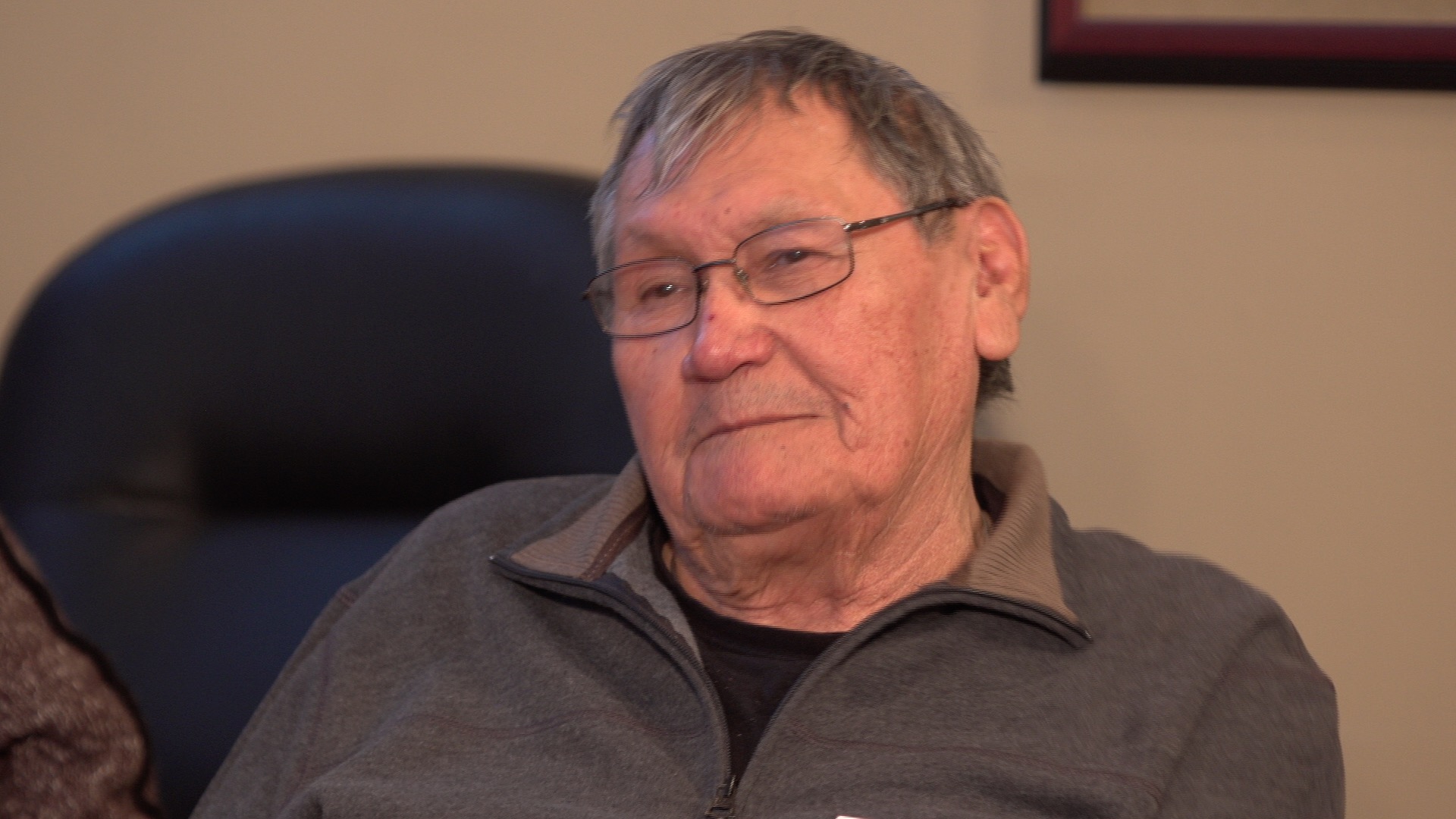Retired ironworker Tom Daniels, in two interviews with the Alberta Labour History Institute (ALHI), explained that the people who did the most dangerous jobs in constructing the skyscrapers in downtown Edmonton in the 1960s and 1970s were almost all Metis men who had trained as ironworkers. That included the CN Tower, built from 1964 to 1966.

It was dangerous work and many men died. Indigenous activist Muriel Stanley-Venne, who led interviews with seven retired ironworkers, referred to their work as “Waltzing with the Angels,” and ALHI titled its video of the interview with those words. Daniels noted that in just one year in this period, 12 ironworkers across Canada died on the job. “My brother fell from a bridge in Fort Vermilion and got killed doing the same thing. My brother Vic fell in Vancouver and got killed. So I lost two of them and numerous friends that fell and got killed.”
Fellow ironworker Hugh Edgar explained that the deaths occurred because when it came to health and safety procedures, “there really wasn’t any to speak of.” There were no safety harnesses. Tom Daniels explained that, “We didn’t have the luxury of steel-toed boots, safety belts, nothing, not even snap-on hooks. We made our own. You come to the job. You got a hook? No. Here’s a piece of rebar; make one.”
“That was the whole thing,” said Daniels. “I think the reason, in my estimation, is get the job done. That was the whole attitude – get it done. When we were doing the pilasters around the end of the building…there was no guardrail. There was no walkways on there — you had to use your own plank, and sometimes you had to move your plank ahead to the next one. They were not nailed down. We were in too much of a hurry to get it done. We didn’t wait for the carpenters to come up and make it nice for us. We’d probably get lost if it had been safe for us. We wouldn’t know what the hell to do. That’s what the whole safety was all about. The speed of the job, the speed of the work: it was go. I think every one of us on the site were running around 110 percent all the time – just go, go, go. That was the nature of what we were doing.”

These young Metis men, none of whom had completed high school, mostly grew up outside Edmonton and became friends in the city as they sought out associations with other Indigenous people in town. They learned how to scale seemingly impossible heights and to work with steel and rebar to build buildings and bridges. On the job building skyscrapers, they even ate their lunch on a beam. When several of them worked at McCurdy Steel, according to Ivan Beauregard, “we were called McCurdy’s Indians. If you wanted something done, we’d get out there and get it done.”

Edmonton’s CN Tower, the tallest building in Western Canada from 1966 to 1971, was their greatest achievement. It was planned for a three-year build, but the determined Metis ironworkers helped cut a year from that schedule. They worked 12-hour shifts. The night shift welded columns together to the top of the tower while the day shift put mounds of steel in slabs and then installed slabs floor by floor. Hugh Edgar described daytime work this way: “We had to put the beams in and then the slab, and it usually took three or four days. It was hard work. There were 11 bars, 60 feet long. I was only 140 pounds and them bars were 300 pounds that we were carrying.”
The men combined their strong work ethic with camaraderie and a sense of fun. Though mostly married men with families, they competed in a variety of amateur rodeos during rodeo season. An incentive for working at top speed was the time they would spend relaxing together afterwards. As Tom Daniels noted, “Some company would maybe put a single mound of steel in a slab in eight hours. We would throw that thing in five hours…It was hard work but you worked your ass off because you’re done at 4:30 and you’d go to the bar and have a beer.”
That hard work earned them a miserly wage of 98 cents an hour when they began working on the CN Tower in 1964, just above minimum wage. But the Ironworkers Union enrolled them as members and negotiated a doubling of their wages by 1966. Ironworker Homer Doucet commented: “The union brought our wages up…I didn’t have to tell them I was Metis.”

Photo by David Murray, 1968.
The Metis ironworkers were willing to have non-Indigenous workers join them. The Unemployment Insurance Commission sent unemployed workers for the Metis ironworkers to train. But the heights and dangerous conditions terrified them, and the established ironworkers had to save their lives and send them back to the UIC. Tom Daniels recalled that these new arrivals would get on a beam and “they’d sit down and you couldn’t budge them. They were frozen. It wasn’t cold; it was just because they were so goddamn scared that they would not let go…The biggest guy would go behind him and then the other guy would smack him in the onion, knocked cold. Then we’d bring the cage up[1] and put him in the cage and then take him back down to the ground.”
While their Metis heritage united the young ironworkers, most denied ever experiencing discrimination in settler Alberta. Nonetheless, the descriptions of the seven ironworkers of their diverse work lives and the work lives of their parents underlines a theme that is central to ALHI’s interviews with Indigenous workers: whatever discrimination they faced in settler colonialist Canada, most Indigenous people are in the labour force rather than on social assistance. [2] Many Indigenous people have been unable to find work, and that has often created a stereotype of Indigenous people not being participants in the labour force. In reality, most Indigenous households have usually had one or more members involved in the labour force. Sometimes they have had high-powered jobs and sometimes menial ones. More often than not, their contributions to building Edmonton, Alberta, and Canada have been invisible to mainstream society.
In the case of the ironworkers responsible for developing downtown Edmonton, that visibility was particularly lacking because the workers who were building skyscrapers were hundreds of feet above the ground.
The Alberta Labour History Institute (ALHI) is an Edmonton-based organization that collects, preserves, and disseminates the stories of Alberta’s working people and their organizations. Their website includes full transcripts, podcasts, and profiles of their interviewees. It also includes videos, booklets, themed essays, annual calendars, and a link to a book created by ALHI. Longtime Indigenous activist Muriel Stanley- Venne, founder of the Institute for the Advancement of Aboriginal Women, became active in ALHI in the early 2000s. She proposed the idea of ALHI doing interviews with various Indigenous workers with particularly interesting stories. That included a group of Metis ironworkers with whom she was well acquainted because relatives, including one of her brothers was among them.
[1] A temporary construction elevator.
[2] In 2022, for example, 60.5 percent of Aboriginal people of all ages were in employment, versus 68 percent for the population as a whole. https://www.statista.com/statistics/484977/labor-participation-rate-in-canada/#:~:text=In%202022%2C%20the%20labour%20participation,of%20the%20labour%20participation%20rate. and https://www.statista.com/statistics/1155888/aboriginal-employment-rate-canada/
Bibliography
Alberta Labour History Institute, “Interviews Relating to Indigenous Workers in Alberta,” retrieved 16 September 2024.
Alberta Labour History Institute, “Métis Ironworkers: CN Tower Interview Transcript I,”, retrieved 16 September 2024.
Alberta Labour History Institute, “Métis Ironworkers: CN Tower Interview Transcript II,” retrieved 16 September 2024.
Alberta Labour History Institute, “Waltzing with the Angels,” video. Retrieved 16 September 2024.
Andersen, Chris. “Métis”: Race, Recognition and the Struggle for Indigenous Peoplehood. Vancouver: UBC Press, 2015.
Campbell, Maria. Halfbreed. Toronto: McClelland and Stewart, 2019, orig. pub. 1973.
Dobbin, Murray. The One-and-a-Half Men: The Story of Jim Brady and Malcolm Norris, Métis Patriots of the Twentieth Century. Toronto: New Star, 1981.
Finkel, Alvin. Working People in Alberta: A History. Edmonton: AU Press, 2012.
Teillet, Jean. The North-West Is Our Mother: The Story of Louis Riel’s People, the Métis Nation. New York: HarperCollins, 2021
Weitzman, David. Skywalkers: Mohawk Ironworkers Build the City. New York: Roaring Brook Press, 2010.

